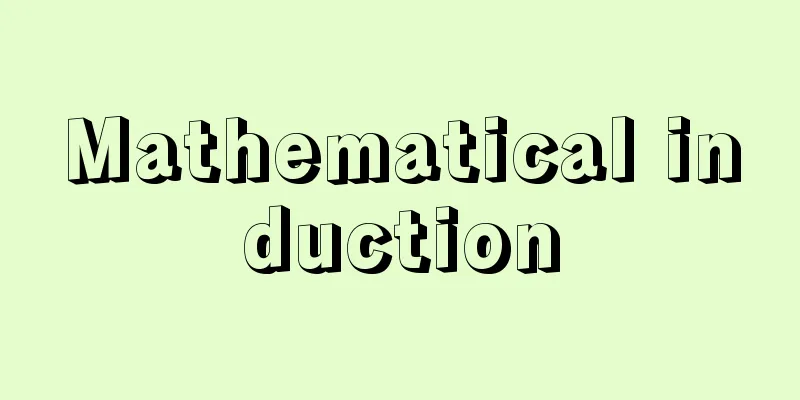Mathematical induction

|
A method for proving or defining a proposition involving variables over natural numbers by focusing on certain properties of the natural numbers. When p ( x ) is a predicate about the natural number x , it is known that the property of natural numbers is that "if p (1) is true, and if for any natural number k , then if p ( k ), then p ( k +1), then for all natural numbers n , then p ( n )." A proof or definition that uses this is called a proof by mathematical induction, and a definition by mathematical induction (inductive definition). for example, Next, let us define a sequence { a n } by mathematical induction. When n = 1, define a n as 1, that is, a 1 = 1. Assume that a k is defined when n = k , and define a k +1 = a k · ( k + 1) when n = k + 1. This kind of definition by induction is as follows: There are various forms of mathematical induction, such as "For any natural number k , if p ( m ) then p ( k +1) for all natural numbers m ≦ k , then p ( n ) is true for all natural numbers n ." The name of mathematical induction comes from the fact that its form is very similar to "induction," and its content is a type of "deduction" since it examines all of the objects. For this reason, it is also called complete induction. [Ken Hirose] [Reference] |Source: Shogakukan Encyclopedia Nipponica About Encyclopedia Nipponica Information | Legend |
|
自然数上の変数を含む命題に対し、自然数のある性質に着目して、その命題を証明、あるいは定義するための手法をいう。p(x)を自然数xについての述語とするとき、自然数の性質として、「p(1)が成り立ち、かつ、任意の自然数kについてp(k)ならばp(k+1)である、が成立すれば、すべての自然数nについてp(n)である」が成り立つことが知られている。このことを用いた証明あるいは定義が、数学的帰納法による証明であり、数学的帰納法による定義(帰納的定義)である。 たとえば、 次に、ある数列{an}を数学的帰納法によって定義してみよう。n=1のとき、anを1、すなわち、a1=1と定義し、n=kのときakが定義されていると仮定して、n=k+1のとき、ak+1=ak・(k+1)と定義する。このような帰納法による定義は、 数学的帰納法には、「任意の自然数kについて、m≦kなるすべての自然数mに対しp(m)ならばp(k+1)である、が成立すれば、すべての自然数nについてp(n)が成立する」など、いろいろな形式のものがある。なお、数学的帰納法は、その形式が「帰納」にきわめて似通っていることからきた名称で、内容は、対象のすべてを調べるのであるから、「演繹(えんえき)」の一種である。このため、完全帰納法ともよばれる。 [廣瀬 健] [参照項目] |出典 小学館 日本大百科全書(ニッポニカ)日本大百科全書(ニッポニカ)について 情報 | 凡例 |
<<: Mathematical structure - mathematical structure
>>: Sogakuji Temple - Sugakuji
Recommend
Karahashi Arira - Karahashi Arira
...The family originated from Ariyoshi, the secon...
Ham language - Ham
A general term for Egyptian, Cushitic, Berber, and...
Nougat - English spelling nougat French
A type of soft candy. Sugar and starch syrup are ...
Schenectady - Schenectady (English spelling)
A city on the south bank of the Mohawk River in e...
Kloos, Willem Johan Theodor
Born: May 6, 1859 in Amsterdam [died] March 31, 19...
Foreigner - Ijin
〘noun〙① An unusual person. (i) A person with outst...
Ataxiasite - Atakisite
Please see the "Lumpy iron meteorite" p...
Morichika Unpei
A socialist of the Meiji period. Born in Okayama ...
Chemiluminescence - chemiluminescence
Like fluorescence, it is light emitted by transit...
National medical care expenditure
The Ministry of Health, Labor and Welfare estimat...
Accounting General - Kaikei Sosai
The highest position in the Shogunate's financ...
Partial pressure
In a gas mixture, the pressure shown when each com...
Felling and bucking
Felling trees is the process of felling them, remo...
linearly dependent
...Generalizing this concept, linear independence...
Oyama Fudo
→Daisenji Temple Source: Shogakukan Encyclopedia ...






![Assam [State] - Assam](/upload/images/67cad51eb4c4c.webp)


